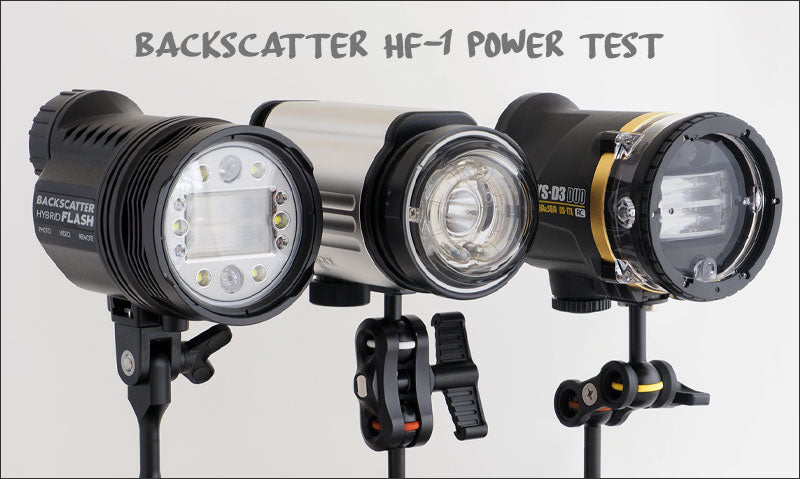Your Cart is Empty
camera packages
housings
Arms and trays
Accessories
BACKSCATTER HF-1 FLASH POWER TEST
July 23, 2024 4 min read

Japanese manufacturers used to have almost a monopoly on underwater strobes. The two manufacturers; Inon and Sea & Sea were really the only decent choices for an underwater photographer who wanted a compact and up-to-date strobe unit. Fast forward 10 years and today the Chinese designers and manufacturers are the ones bringing out high-quality products into the market. The latest example is the Backscatter Hybrid Flash 1 or the HF-1. Backscatter company is, of course, hailing from the USA, but most of their products, including the HF-1 strobe, are designed and manufactured by AOI in China.
AOI is probably today the world’s biggest underwater photography equipment manufacturer, designing units for brands like Backscatter, Olympus/OM-Systems, Fantasea, etc… On top of this, AOI offers a wide range of products under their own brand name. Furthermore, many AOI products can be bought either branded as Backscatter or AOI. However, the Backscatter strobes like the Mini Flash and the new Hybrid Flash HF-1 can only be purchased via Backscatter themselves.
The Backscatter HF1 Hybrid strobe features

The new Backscatter strobe is called hybrid because it packs a powerful GN40 strobe with a 5000–lumen video light into a reasonably compact unit. Getting its power from two off-the-shelf Li-ion batteries (21700), it weighs only 1.1kg on land and 227gr underwater with the batteries installed. The HF-1 offers the same Olympus/OM system -compatible RC/SC optical flash control mode that was available on Backscatter’s earlier Mini Flash macro strobes. A new added feature is that the SC smart control mode now works even with certain Sony cameras with internal pop-up flashes.
The HF-1 is partly made of aluminium which also works as a heat sink as the GN40 flash generates quite a bit of heat. On full output at GN40, the strobe recycles in 2.17 seconds. Doesn’t sound too fast but drop the power to ¼ and you can already do 10 frames per second. Incredibly the HF-1 manages 30 frames per second at 1/16th power. That is fast! You should be able to get up to 370 full discharges from the two fully charged batteries. At a GN34 setting (one step down from the full power), according to the manufacturer, batteries can last up to 800 shots.
HF-1 flash tube is surrounded by a plethora of different LEDs that have a multitude of functions; On top of the standard 5000-lumen wide-angle video light, there is a spotlight, a red light, a beacon-style safety light and focus lights that help to focus in dark and turn off when the strobe fires. A range of different add-on diffusers are also available to control the light temperature and spread. For example, with the new dome diffusers, the angle of the strobe beam can be expanded to up to 140 degrees.
The test
For years I’ve been testing strobes of all kinds with my trusty old Minolta Flash Meter V (used to be the top-of-the-range flash meter back in the day). This meter measures flash power in one-tenth of an aperture accuracy. Many newer flash meters measure the power in a quarter of stops instead. But for ultimate accuracy, the results here are shown in full stops, for example, f8, and then a decimal. So f8 and 2 would mean a power reading of a bit above f8 and f8 and 9 would almost be f11… just to give an example.
For the following test, I have pinned the Backscatter HF-1 against two reasonably new powerful strobe units; The Sea & Sea YS-D3 DUO RC and Kraken KR-S160. On paper the HF-1 should be the most powerful, promising a max output of GN40. The Sea & Sea YS-D3 DUO RC boasts a max GN of 33. With the Kraken, it gets a bit more complicated as they only give out a watt-second power of 160 for their light. The watt second is a measure of energy rather than an f-stop, which in many ways is a more truthful way of measuring power. The only way to compare them is to measure them with a light meter...
Results:
The measurements were taken without and with the standard (included) diffuser, from a 1m distance.
- Backscatter HF1: f16 and 8 (without), f16 and 5 (with)
- Sea & Sea YS-D3 DUO RC: f16 and 5 (without), f11 and 9 (with)
- Kraken S160: f11 and 9 (without), f11 and 5 (with)
The HF1 is the most powerful of these 3 by a few decimals and also seems to have a slightly thinner standard diffuser that lets lots of light through. The Sea & Sea YS-D3 DUO RC is not far behind. With the diffusers on the difference is only half a stop. The Kraken K-S160 performs decently also, however, there is a small issue. The S160 has a ring-shaped flash tube and without the diffuser, it leaves a shadow area in the middle of the frame. Measured from exactly in the middle from 1m away the K-S160 output is only f11.5 without a diffuser and from a slight angle f11.9. This means that the K-S160 strobe can really only be used with the diffuser on, which luckily eliminates the issue.
Final Words
The HF-1 is not cheap at £875 (in the UK). But it is crammed so full of different features that it sits in its own class. Today buying an advanced automatic underwater strobe and a good video light in one package is a reality. With the HF-1 and the earlier Mini Flash 2 AOI/Backascatter have pushed underwater strobe technology to a new level and are now the leaders in this field. Can the Japanese manufacturers catch up anymore? We shall see.
Read more about the Backscatter HF-1 HERE
Subscribe
Sign up to get the latest on sales, new releases and more …
